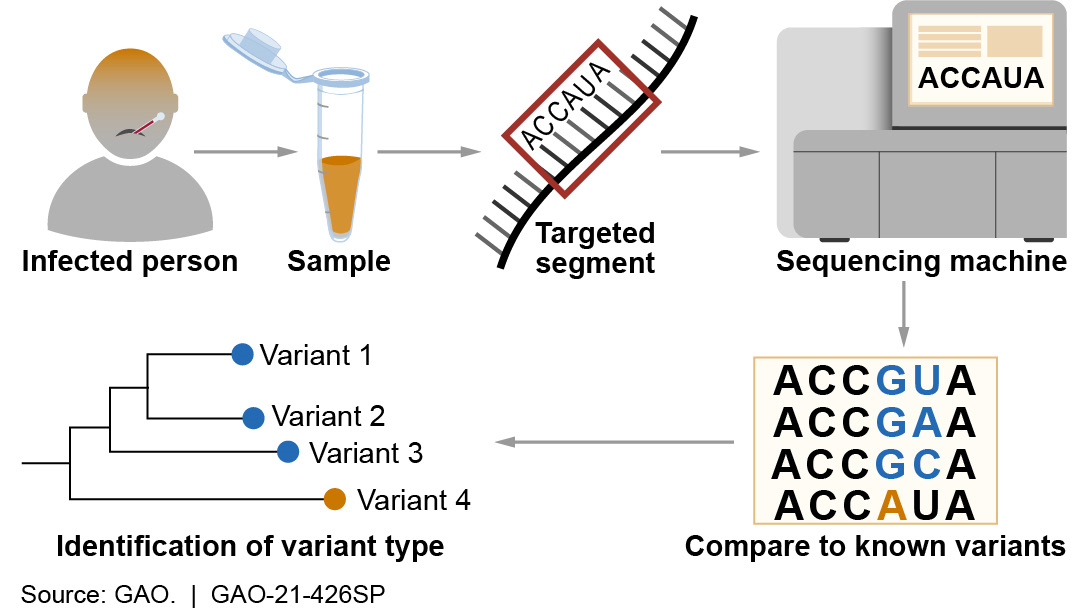Public health agencies are adopting pathogen genomics to improve outcomes in a wide variety of infectious diseases. New tools allow earlier detection and more accurate investigation of disease outbreaks. An abundance of data contributes to research for future applications as well as the development of therapeutics and preventive measures, such as vaccines.
What Is Genomic Sequencing?
Genomic sequencing allows scientists to look at a pathogen’s genetic footprint. Every strand of DNA (or RNA in some viruses) is comprised of a sequence of four chemical “letters.” A base is formed from each of these letters. The order, or sequence, of these bases displays information used by researchers to combat disease.
First-generation Sanger sequencing used fluorescent tags to read letters of the genetic code. New technologies such as next generation sequencing (NGS) are faster and can work on longer strands of DNA, as well as being able to review millions to billions of sequences at the same time. Compared to the older Sanger sequencing method, NGS cuts down on costs by more than 1,000 times when using larger samples and it is vastly faster.
How Does NGS Help Fight COVID-19?
The severe acute respiratory syndrome coronavirus 2, or SARS-CoV-2, was sequenced and the code made public in January 2020. Scientists began working on a diagnostic test almost immediately and developed one within weeks. Two teams of scientists began work on a vaccine against the disease that used genetic material from the virus, known as mRNA. After development and testing that showed 94% and 95% efficacy, the Moderna and Pfizer vaccines were authorized for use in December 2020.
Other pharmaceutical companies use the virus’s genetic code to develop other types of vaccines and antivirals to help treat people who already have the disease. Scientists also use the genetic blueprint to determine how immune systems will react and who may need earlier treatment. Finally, researchers are continuing to track changes in the genetic code that could require targeted drugs and new vaccines.
“Genomics and genomic epidemiology have emerged as an incredibly powerful tool in fighting this pandemic,” says Francis deSouza, CEO of genetic-sequencing machine fabricator Illumina. “And they will be essential to how we fight future biological threats, whether it’s the next coronavirus or antimicrobial resistance or even bioterrorism.”
Tracking Spread
Genomic sequencing can be used in many areas of infectious disease research. Data can enable researchers to track distribution and spread in a group of people or animals, and use this information, called genomic epidemiology, to react to outbreaks.
Outbreaks of flu, tuberculosis, bacterial enteric illness, and even potential agents of bioterrorism can be subtyped and more easily managed via genomic sequencing. The technology can be used to determine antimicrobial resistance in Strep, serotype E. coli, and Salmonella, thus eliminating the need to obtain serum panels, and check for virulence factors, such as the presence of Shiga toxin, in E. coli, among many others.
Caveats
There are limits to the use of NGS in the public health arena that may prevent its widespread use in some applications.
- Sensitivity. Genomic sequencing requires millions of copies of genetic material from the pathogen being examined.
- Cost. Although the cost has come down dramatically since first-generation sequencing, NGS cannot be performed without expensive laboratory equipment, computer resources, and trained personnel.
- Privacy. To counter outbreaks of infectious disease, data must be processed, shared, and linked in ways that could potentially allow the identification of infected individuals or those carrying new variants, possibly leading to discrimination or stigmatization.
- National security. State or non-state entities could utilize NGS along with gene-editing technology to modify the survivability of pathogens as an effort at biological warfare.
Next-generation genomic sequencing has proven its value to public health and will continue to mold treatments and policy in the future. Policymakers, academic institutions, and private philanthropies must use their combined resources to support and broaden its use while safeguarding the confidentiality and security of public citizens.






